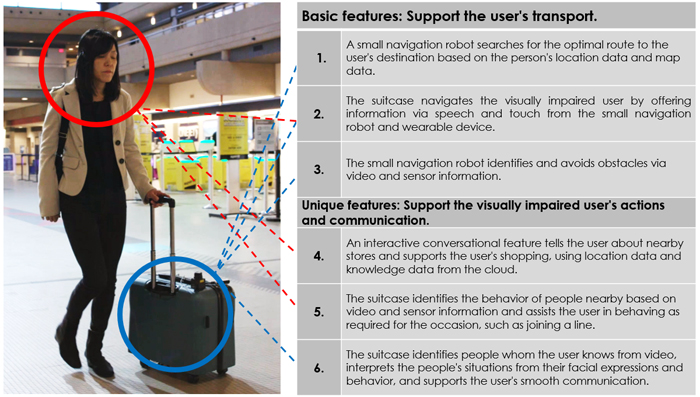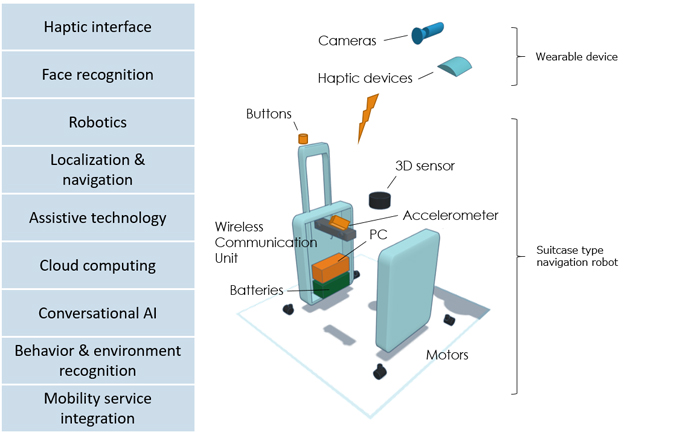Download PDF[329KB]
Alps Alpine Co. Ltd.
OMRON Corporation
Shimizu Corporation
IBM Japan, Ltd.
Mitsubishi Motors Corporation
OMRON Corporation
Shimizu Corporation
IBM Japan, Ltd.
Mitsubishi Motors Corporation
Alps Alpine Co. Ltd. (headquartered in Ota District, Tokyo; Representative Director, President & CEO Toshihiro Kuriyama), OMRON Corporation (headquartered in Shimogyo District, Kyoto; President and CEO Yoshihito Yamada), Shimizu Corporation (headquartered in Chuo District, Tokyo; President and Representative Director Kazuyuki Inoue), IBM Japan, Ltd. (headquartered in Chuo District, Tokyo; General Manager Akio Yamaguchi), and Mitsubishi Motors Corporation (headquartered in Minato District, Tokyo; Representative Executive Officer and CEO Takao Kato) have established the Consortium for Advanced Assistive Mobility Platform, a general incorporated association. Aiming to improve accessibility in society (*1) and quality of life for the visually impaired, the consortium will develop an integrated technological solution (hereafter called an "AI suitcase") that will support people's transport and communication with AI, and will conduct pilot experiments and demonstrations toward ultimate implementation in society. Through its activities, the consortium aims to achieve a co-living society in which people, regardless of any disabilities they may have, can live together with mutual respect for one another's individuality.
Background to the Consortium's Establishment
In recent years, the number of people with visual impairments is on the rise due to age-related declining vision and the onset of eye diseases such as glaucoma. A survey by the Japanese Ophthalmological Society (*2) estimated that there are 1.64 million people in Japan with visual impairments, of whom 188,000 are completely blind. Some research results (*3) suggest that across the globe, the number of visually impaired people will triple by 2050, leading to increasing concern about this exponential increase in number.
People with visual impairments face a number of challenges; among these, one of the largest hurdles that prevents social participation is the inability to move around town freely. For instance, it is extremely difficult for the visually impaired to do everyday tasks, such as to check their route on a map and head to a destination, to walk on the street while avoiding people or objects, to enter shops after checking signs and signboards, to line up at train stations and stores, or to spot someone whom they know and to greet the person. Since the enactments of the New Barrier Free Transport Act in June 2006 and the Disability Discrimination Act in April 2016, more measures have been implemented in Japan for people with disabilities, including eradicating steps and adding elevators to improve accessibility for wheelchair users. However, people with visual impairments who cannot visually look around and check their safety still face challenges in their social lives, including during commuting to work and school.
To resolve these issues, the consortium will work to develop an AI suitcase, an integrated solution that will help the visually impaired to get around town independently, by supplementing visual information by combining the latest AI with robotics. This AI suitcase is a wearable device and suitcase-shaped navigation robot designed for the visually impaired; it can be carried around easily without stress in one's daily life. Under this consortium, multiple companies in various fields of business will bring together their technologies and expertise to develop such an AI suitcase. Through pilot experiments, the companies will identify the requirements for social implementation and aim to achieve a solution that resolves transport and communication issues for the visually impaired.
The consortium was inspired by the research that IBM fellow Chieko Asakawa conducted at Carnegie Mellon University (U.S.) on navigation for the visually impaired. The consortium will join hands with universities including Carnegie Mellon as well as relevant organizations that support the visually impaired in order to develop new accessibility technologies. (*4)
*1 Accessibility: Ease of access to information and services.
*2 Source: "Social cost of visual impairment in Japan," 2006–2008, Japanese Ophthalmologist Society study group
*3 Source: "Magnitude, temporal trends, and projections of the global prevalence of blindness and distance and near vision impairment: a systematic review and meta-analysis," August 2017, Lancet Global Health
*4 Guerreiro, João, Daisuke Sato, Saki Asakawa, Huixu Dong, Kris M. Kitani, and Chieko Asakawa. "CaBot: Designing and Evaluating an Autonomous Navigation Robot for Blind People." In The 21st International ACM SIGACCESS Conference on Computers and Accessibility, pp. 68-82. 2019.
Overview of the Consortium
|
Name
|
Consortium for Advanced Assistive Mobility Platform
(CAAMP, a general incorporated association) |
|
Address
|
Chuo District, Tokyo
|
|
Established
|
December 20, 2019
|
|
Purpose
|
Development of the AI Suitcase, an integrated solution device
that contributes to improving accessibility and quality of life (*5) of the visually impaired in society, by utilizing AI to help them move around independently, and conducting pilot experiments toward social implementation |
|
Main activities
|
|
|
Activity period
|
December 1, 2019 – November 30, 2022 (as scheduled)
|
|
Participants and their roles
|
5 companies (as of February 2020, in Japanese alphabetical order)
|
*5 Quality of life: One indicator of people's satisfaction with life
Fig. Configuration (or Image) of the AI Suitcase
(FYI) Components of the AI Suitcase

